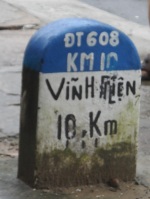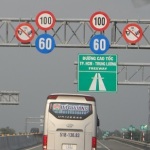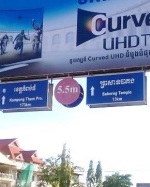John Frewen-Lord follows his article reflecting on his visit to Hong-Kong with another about two of the countries that once formed French Indo-China.
I recently spent a total of 18 days on an extensive tour of these two countries. In all of that time, not once did I come across a single instance of non-metric usage. Considering that both of these countries (but especially Vietnam) were occupied by American forces during the Vietnam War and the Cambodian Campaign, this came as a bit of a surprise.
But it shouldn’t have done so. During the Vietnam War (which the Vietnamese call the American War, to distinguish it from all the other wars in the country’s history), some 60% of the male population was wiped out. A whole generation was essentially lost. The result is that today over half of Vietnam’s 93 million population is 25 or younger. And they have never had any contact whatsoever with non-metric measurement units.
Cambodia, whose development is about 25 years behind that of Vietnam, suffered similar devastation to its population, this time under the despotic rule of Pol Pot, who slaughtered untold millions of the country’s citizens. Again, a whole generation was lost, and only now is Cambodia rebuilding its human resources. Like Vietnam, the majority of its current population is young. And solely metric-educated.
Which may explain the use of only the metric system in these two countries – there are a few of the older generations using ‘legacy’ units of measurement (whatever they might have been). Consequently, no-one uses – or even knows – anything other than metric units. Even the old ladies working on market stalls and the like used scales that measured in kg only.
Vietnam in particular is a country very much on the ascendant. Its population is intelligent, resourceful and dynamic, while a major program of industrialisation is under way. Countries like the UK refusing to complete metrication need to be aware that South East Asia, especially countries like Vietnam, will leave them behind if this part of the world that is resolutely metric continues progressing at its current pace.
One man on our tour was an ex-Brit living in the USA, who refused to use or even attempt to understand metric units. On a trip on the Mekong river on a fairly small boat, the boat’s captain asked each of us how much we weighed, and then told us where to sit, in order to maintain the boat’s stability. Almost all of us – mostly Aussies, Kiwis and Brits – were able to give our weights in kg (there was a bit of a discussion among a British couple in converting stones to kilos, but they got it right pretty quickly). The sole exception was our ex-Brit, who proudly gave his weight as 200 pounds. The captain again asked how much he weighed. Realising that 200 pounds meant nothing to the captain, the culprit looked to me, whereupon I made the conversion to kg.
Vietnam
Our tour guide, a Vietnamese young man in his late 20s, spoke in metric terms exclusively. This was also true for bus drivers, boat crew, hotel staff, shop keepers, market stall holders, etc. – in fact anyone I came into contact with.
The following shows many of the signs I came across, as well as some comments. Note that many road signs were taken through the side windows of moving buses on sometimes bumpy roads, so if some pictures are a bit blurred or taken at strange angles, please bear with me! Also to be noted is the somewhat casual mixing of upper and lower cases, both private signs and those erected by the authorities. Obviously a little work needs to be done here in getting metric usage right. Road signs in Vietnam were exclusively international in style, including the use of a yellow background on triangular warning signs. Click on the images if you wish to enlarge them.
Taken at a petrol station in Ho Chi Minh City (Saigon).
Typical information board at the War Remnants Museum, Saigon.
A couple of private signs in Hué.
A rather weather-beaten kilometre post.
At a bespoke tailor’s in Hoi An.
Sometimes they get it right – and sometimes not.
On the Hai Van Pass.
Pity about the incorrect use of upper case.
Entrance to underground car park in Saigon.
Note the distance of 100 m between trucks, as well as the minimum speed of 60 km/h. The 0-50-100 m posts are to measure the speed of vehicles.
Digital direction signpost
In Vietnam? Not a chance…
Cambodia
Like Vietnam, the population in the Kingdom of Cambodia, around 15 million, knows only metric units – imperial values mean absolutely nothing to them. Our Cambodian tour guide spoke exclusively in metric units only. On occasion, our ex-Brit asked him to convert some values to imperial units, but his request was met with a blank stare. (Not to mention that the Aussies and Kiwis were becoming visibly annoyed at his obstinacy.)
Road signs were a mix of North American (or Australian) for warning signs (yellow diamond), and international for regulatory (red-rimmed white circle). As in Vietnam, the use of upper and lower case letters was haphazard.
Around 15% to 20% (possibly more in rural areas) of all cars, vans and trucks were right hand drive, imported from neighbouring Thailand. This practice has been stopped for some time, and today what little vehicular cross-border traffic there is consists mostly of either large trucks with special permits, or government vehicles. At the border into Thailand, we had to change buses, as left hand drive vehicles are not allowed in Thailand. In the ‘no-man’s-land’ between Thai and Cambodian border controls, only one vehicle is allowed in at a time, making the transition from right to left side of the road or vice versa. In the hour it took to exit Cambodia and enter Thailand, I saw just two vehicles go through, an SUV on Thai government plates, and a large truck. On the Thai side a large queue of trucks was waiting to cross into Cambodia.
Not all height restriction signs were of this style.
A more conventional height restriction sign.
Probably the most ignored sign in S E Asia.
Situated in Siem Reap. Note yellow diamond cross roads warning sign in distance.
Every major roundabout in Cambodia had a huge statue on the lines of this one, depicting some aspect of Cambodian culture.



















Vietnam and Cambodia may be foreign countries but the signs are less foreign to me than those in Britain due to the use of measurement units I understand.
LikeLike
Vietnam where “No Entry” is merely an advisory. Where noodle stands line the exit ramp of the expressway.
Try Myanmar or Malaysia if you really want an imperial-metric mishmash.
Jack, Penang
LikeLike
What I’ve noticed when abroad, is that some of the symbols aren’t used officially all over the world; I don’t know whether the forum software is capable of this, but Russian publications / speedometers regularly used ??/? instead of km/h, and weight limit signs use the cyrillic ? instead of t for tonne.
In Scandinavia it isn’t uncommon to see km/t (kilometres per tonne?) or km/tim (Sweden) on some signs, particularly those for minimum speed limits.
In fact, in Russia I only noted the correct international symbol used was for ºC, despite being there for four months! (the BA check-in desk at St Petersburg airport handily says the hand luggage weight limit is “8 ?? / 17 lb” – not tremendously useful for a modern person who cannot read cyrillic.
So, whilst John is correct regarding the misuse of upper case in some of these signs, it’s still much better than a lot of countries where the symbols are all but ignored.
LikeLike
@Jackthesmilingblack:
So what’s your point?
I agree that Vietnam has very different ideas on road traffic compared with the UK and other countries (although, in spite of what seems like anarchy on the roads, it does seem to work). But that has nothing to do with the thrust of my article.
LikeLike
In Scandinavia, km/t = kilometer i tim(m)en = kilometres per hour (or, literally, “kilometres in the hour”): so, it’s just a localised form for the usual km/h (t = h)…
LikeLike
To Charlie:
km/t is indeed not the correct international symbol; ‘time’ is the Norwegian and Swedish word for ‘hour’.
How arrogant can one be? Travelling to a metric country and expecting the people there to understand non-metric units and to convert metric to non-metric for him. This ‘ex-Brit’ needs a lesson. I hope that one day he will be driving 100 miles per hour in Europe where 100 km/h is allowed and that the police will give him a hefty fine. In the Netherlands driving more than 50 km/h over the limit means the culprit loses his licence for a time and the fine is hundreds of euros!
I went to Ireland for the first time in 1971 and she was a full blown Imperial country at that time, but Celsius was starting to make inroads. The pilot stated temperatures in Manchester and Dublin in degrees Celsius (not Centigrade). I learned the Imperial units which I was was going to encounter and I used them as long as I was there. This is simply the decent thing to do.
LikeLike
@ Charlie:
Some countries do indeed ‘localise’ metric symbols and ‘km/t’ or km/tim’ are examples of this: the Swedish for ‘hour’ is ‘timma’. In the Dutch-speaking parts of Belgium you also see ‘km/u’ where the letter ‘u’ represents the word ‘uur’, Dutch for ‘hour’.
Since Sweden and Belgium are members of the European Union, I am sure they are both in breach of European weights and measures legislation by not using the agreed (SI) metric symbols.
By the same token the UK is probably in breach of the same European legislation by not challenging the use of ‘miles per hour’ for wind speed, despite ‘mph’ only being mandated for use in connection with road traffic.
LikeLike
I’m Italian and I don’t know English language very well.
But I know that Vietnam and Cambodia were French colonies.
Why should they remember Britain’s or America’s strange measures?
LikeLike
Thank you to people who clarified the km/t abbreviation above; the ??s in my post were also supposed to indicated Cyrillic letters which have replaced the Latin script in metric symbols in Russia.
it is a shame that some countries “localise” the symbols; as the idea of them is that they’re universally understood – which can’t be so if they’re changed in every country, obviously! (though I guess at least km/h looks like km/t, and km/u rather than the dreaded “kph” or even “kmph” I saw the other day!)
@ Jake re: wind speeds in mph
I’m not sure the UK would be *strictly* in breach here; as the Met Office (presumably the only weather forecaster which would need to meet the requirements due to it being a government body) does offer wind speed in mph, km/h, m/s, kt, and Beaufort (?) – so SI options km/h and m/s are offered, but perhaps one could challenge the primary status that mph has over km/h or m/s. If the Met Office changed their primary wind speed, and that which they used in weather warnings as the primary; we’d probably see mph relegated to secondary in most places as people would tire of converting. Here’s hoping!
@ Han Maenen (in case the comment about imperial abroad is aimed at myself)
I certainly don’t expect others to understand imperial units; as I can’t really grasp them myself! – I am 1.81 m tall and weigh about 100 kg. I was merely pointing out that it would generally be nice to see the proper symbols used everywhere to help with general comprehension.
LikeLike
@ Charlie
I apologize. My comment about the ‘Ex-Brit’ was certainly not aimed at you, but at ‘ugly tourists’.
LikeLike